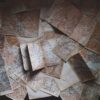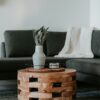Preparation Steps
Getting your coffee table ready for a fresh coat of paint is your top priority before diving in. Prepping the surface right keeps the paint stuck on and makes your table look like it just strolled out of a showroom.
Cleaning and Surface Inspection
First up, grab a damp cloth and give your coffee table a good wipe-down. You don’t want any dust bunnies or grime messing with your paint job. If your table’s been camping out in the garage or collecting cobwebs, mix in a bit of mild detergent to tackle those tough spots (Erin Spain).
After it’s all cleaned up, time to play inspector. Check every inch for dents, scratches, or any old finish peeling away like a bad sunburn. Even if your table is laminate, peek under the surface to catch any loose veneers trying to make a getaway. Nailing these issues ensures your paint job won’t be a one-week wonder (JC Licht).
| Step | Action |
|---|---|
| 1. | Wipe down the table with a damp cloth. |
| 2. | Use a mild detergent for stubborn dirt. |
| 3. | Inspect for dents, scratches, or peeling. |
| 4. | Check the laminate for any peeling veneers. |
Sanding and Removing Hardware
Now, onto the sanding—think of it as giving your table a fresh start. Grab some medium-grit sandpaper, about 120-150 grit, and get to work. This’ll ditch that shiny finish and get the surface ready for primer and paint. Don’t forget the little corners, they deserve attention too. After sanding, take a tack cloth and sweep away the dust like a pro (Erin Spain).
Next, unscrew any knobs, handles, or metal bits. It’s easier to paint and you won’t accidentally give them a new color. Toss the bits in a labeled bag so you don’t end up with a mystery part at the end of the project.
If your table’s got fancy patterns or several surfaces, consider taking it apart to make your job smoother. Remember, prepping and allowing time for paint to dry properly is the secret sauce to a great paint job (Benjamin Moore).
| Step | Action |
|---|---|
| 1. | Use medium-grit sandpaper (120-150 grit). |
| 2. | Sand the entire surface. |
| 3. | Wipe down with a tack cloth. |
| 4. | Remove all hardware. |
| 5. | Disassemble parts, if necessary. |
Treating your table to some solid preparedness makes sure that painting will go down like a breeze. For more on the art of priming and painting, take a peek at our guides on priming techniques and painting methods.
Priming Techniques
When it comes to sprucing up that old coffee table in your living room, priming the surface before you slap on that paint is a game-changer. This step keeps your paint sticking around like a houseguest who won’t leave. So, let’s chat about why primer’s your BFF, the types you can grab off the shelf, and some handy tips for getting it on just right.
Importance of Primer
Here’s the deal: primer helps the paint secure a good grip on your coffee table’s surface, making everything look smooth as butter. I’ve found that going for a separate primer instead of those two-in-one combos does wonders for keeping the paint from peeling off after a week or two (trust me, it’s like giving your table a shot of espresso). Primer also masks any blemishes on the table, ensuring the color goes on even. Whether it’s made of wood or sporting a laminate finish, a primer is your ticket to a job that screams professional.
Types of Primers
You’ve got options, my friend. Here’s a cheat sheet to get you started:
| Primer Type | Best For | Perks |
|---|---|---|
| Water-Based (Latex) | Dry and clean spots | Doesn’t stink up your space, cleans up easy |
| Oil-Based | Covering up stains or darker bits | Blocks out stains like a pro, sticks like glue |
| Shellac-Based | Spots that get a lot of use, wood | Fast-drying, keeps nasties and smells at bay |
Shout out to oil-based primers like KILZ for their magic touch on stubborn stains (Check Erin Spain for more tidbits). Peek at our coffee table makeover ideas for extra pizzazz.
Application Tips
Getting primer on right can be the difference between “wow” and “whoops.” Here’s how you nail it:
- Clean Up Your Act: Start with a clean slate. Get rid of gunk and sand it down so the primer sticks like a champ.
- Thin’s In: Think layers! Thinner coats mean you avoid drips and get an even spread.
- Tools Matter: A good brush or foam roller helps the primer lay on like a dream.
- Keep Your Cool: Be patient. Let each coat dry as per the instructions, usually a day is the sweet spot.
- Smooth Moves: Lightly sand between coats. It’s like buffing up your table to a silky finish.
Using these hacks will have your coffee table looking sharp, ready to make its debut in your home. Whether you’re working with wood or laminate, proper priming sets you up to win the paint game.
Painting Process
Giving your coffee table a splash of new color can work wonders for your space. I’ll guide you through picking the right paint, how to apply it like a pro, and why coatings and sanding are important.
Selection of Paint
Getting the right paint? It’s kinda like finding the right outfit for a night out—look and durability matter. Here’s how to choose:
Type of Paint: Acrylic latex and chalk paints shine for coffee tables. They’re tough and handle all the coffee cups and feet that come their way.
Finish Options: The finish sets the vibe. Matte is mellow, satin is a gentle shimmer, semi-gloss has a bit more pop, and gloss is straight-up shine and style.
Color Talk: Whether you want your table to blend in or steal the show, pick a color that does just that with your room.
Painting Methods
A slick paint job is all about the technique. Here’s how to roll with it:
Brush Work: For those little corners and tricky spots, brushes do wonders. Keep coats fine to dodge those pesky brush streaks.
Riding the Roller: For sweeping flat surfaces, a roller makes life easy and the paint even.
Spray Away: When smooth is your jam, a paint sprayer might be the tool for you. It lays down a neat coat but takes a bit more prep and care to avoid a mess.
Coating and Sanding
Coat and sand—sounds tedious, but it’s make-or-break stuff:
Getting Started: Once your primer’s dry, lay down that first thin coat of paint.
Sanding 101: Between each coat, a gentle rub with fine-grit sandpaper (about 220) kicks out any lumps and bumps, helping the next layer stick better.
Layering Up: Aim for a couple more coats, with a light sand between each for a super-smooth finish. Make sure each coat’s dry before adding another layer.
Table of Recommended Paints and Tools
| Item | Description |
|---|---|
| Acrylic Latex Paint | Long-lasting, a cinch to clean, perfect for tables |
| Chalk Paint | Matte look, easy distressing for a vintage touch |
| Brushes | Awesome for edges and detail work |
| Rollers | Top for big, plain areas |
| Paint Sprayer | Even coverage, slick finish |
| Sandpaper (220 grit) | Key for getting smooth layers |
Helpful Tips
There’s always a hack or two to make your project easier. Check out refinishing a coffee table and coffee table makeover ideas for some creative boosts.
Stick to these steps, and you’ll transform that old coffee table into something that not only looks amazing but becomes a talking point in your room.
Sealing and Finishing
Once I’ve taken the time to restore a coffee table, sealing and finishing becomes the cherry on top. This is the part that makes sure all my hard work sticks around awhile, looking slick and standing the test of time.
Sealing Importance
Every time I slap a fresh coat of paint on a coffee table, sealing is non-negotiable for me. Here’s why:
- Protection: Think of sealant like armor for your paint. It fights off scratches, dents, and everyday chaos.
- Durability: If you’ve got a bustling living room, that extra shield keeps everything looking sharp for longer.
- Easy Maintenance: Make spill cleanup a breeze. Sealant makes the surface easy to wipe down, keeping it looking fresh.
- Enhanced Appearance: Give your table that showroom shine. A good sealant makes it look like a pro did the job.
As JC Licht points out, slapping on a solid topcoat is key for keeping painted laminate furniture looking fab, especially in busy spots.
Sealant Options
There’s a bunch of sealant choices out there, each with its own perks. Here’s the lowdown on some popular picks:
| Sealant Type | Description | Best For | Pros | Cons |
|---|---|---|---|---|
| Minwax Polycrylic (Water-based) | Clear, water-based topcoat | Light-colored paints, indoor furniture | Simple cleanup, less stink | Not as tough on dark or high-traffic spots |
| Minwax Wipe-On Poly | Oil-based, wipe-on method | High-traffic zones, wood tables | Strong, easy to apply | Takes longer to dry, needs ventilation |
| Furniture Wax | Paste wax, rubbed on | Decorative pieces, low-traffic use | Soft shine, vintage vibe | Needs touch-ups, not super durable |
This wisdom comes from (Erin Spain)
For my own projects, I usually go with Minwax Polycrylic. It’s water-based, which means cleanup’s a cinch and you can breathe easy without nasty fumes. Works like a charm on light shades. Erin Spain vouches for it too, saying it’s the way to go for the neatest cleanup and easier breathing. Whatever you use, slather it on in thin coats, giving each layer time to dry before adding the next. Usually, two to three coats do the trick to buffer the paint and give your table that gorgeous finish.
This step locks in your table’s look and toughness, working hand-in-hand with other steps in my refinishing a coffee table saga.
Repainting Techniques
Hey there, let’s spruce up that coffee table of yours together! Whether it’s wooden or laminate, I’ve got the lowdown on how to give it a fabulous facelift. Stick with me, and you’ll nail it—literally and figuratively.
Repainting Wood Tables
Got a wood coffee table that’s seen better days? No worries! We’ll go through some essential steps that’ll have it looking brand new. It’s all about getting the prep right, picking the right paint, and trusting the cure time (Benjamin Moore).
Step-by-Step Guide:
- Preparation:
- Give that table a good scrub to send grime packing.
- Check for any nicks and dents—fix those up.
- Sand down the surface to give the paint something to hold onto.
- Priming:
- Slap on a primer that suits wood like peanut butter on jelly.
- Let it dry—no shortcuts here!
- Painting:
- Pick high-quality paint made for wood; this ain’t the time to skimp.
- Go for light coats and avoid globs. Let each layer dry before the next.
- Sealing:
- Once the paint’s good and dry, use a sealant to lock in your hard work.
Need more personalized advice? Check out our refinishing a coffee table guide for a deeper dive.
Repainting Laminate Furniture
If you’re dealing with laminate, listen up—nailing this requires a bit of finesse with the right gear. Stick the landing by letting primer and paint dry fully (I promise it’s worth it). (JC Licht)
Step-by-Step Guide:
- Preparation:
- Scrub that laminate surface clean, like you’re chasing after a stain.
- Patch up any dings you find.
- A light sanding will help everything stick nicely.
- Priming:
- Use a primer that’s meant for laminate—it knows what it’s doing.
- Let it dry for a good four hours. Have a coffee, relax a bit.
- Painting:
- Choose a paint made for laminate; trust me, it makes a world of difference.
- Apply thin coats and give ’em time to dry in between.
- Sealing:
- Top it off with a sturdy sealant, especially if this table sees a lot of action.
For some creative sparks, our coffee table makeover ideas might just light up your inspiration.
By sticking to these steps, you’ll transform your coffee table, whether it’s wood or laminate, into a showstopper. Prep, prime, paint, and seal—these are your new best friends for this DIY adventure.
Curing and Final Touches
Letting the Paint Settle
So, you’ve transformed that coffee table into a piece of art with primer and two layers of paint. Now, it’s the waiting game. You gotta let the paint settle and harden before putting it back to work. This is where patience comes into play—it’s about making sure everything sticks and stays put. According to the folks over at Benjamin Moore, it’s wise to give it 24-48 hours to cure in a breezy, dust-free zone.
| Action | Duration |
|---|---|
| Touch Ready | 1-2 hours |
| Light Duty | 24-48 hours |
| Fully Set | 7-10 days |
Rushing might cause scratches or dents, and no one wants that on their new masterpiece. Taking your time now means a tougher finish later.
Wrapping it up with Hardware
Once you’ve sealed your furniture, give it a couple more days to just sit there and chill before you dive in and start shifting stuff around. Once the sealant has done its job and the surface is like armor, it’s time for the final cherry on top: the hardware.
This is where you add those drawer pulls, knobs, or any little bling that screams “I have style!” Like Erin Spain says, tag these bits on after everything’s dry for that sleek, pro look. Tighten those screws real good and check if they’re in line—you want your table to look snazzy and function well, right?
Curious for more? Take a peek at our guides on refinishing a coffee table and coffee table makeover ideas for the 411 on doing up your space.









